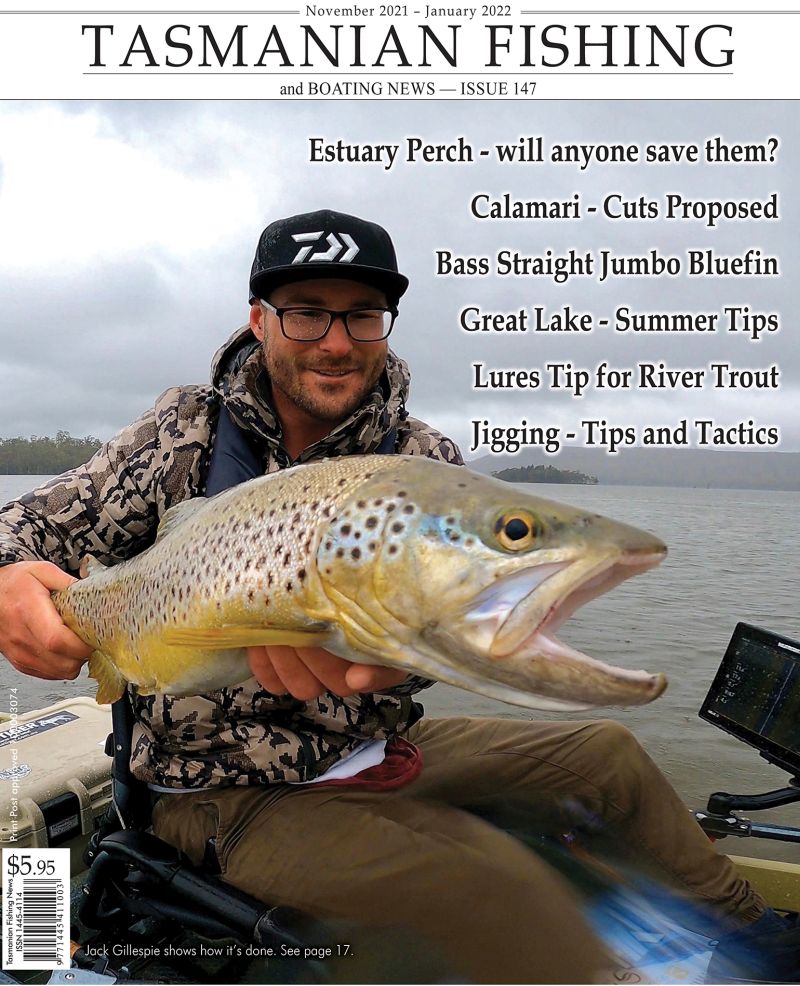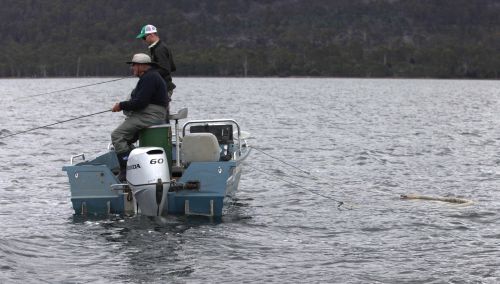From the Archives ...
Atlantic salmon the hard way
Atlantic salmon the hard way
Scott McDonald
The first Atlantic salmon eggs used to begin Tasmania's Atlantic salmon aquaculture industry were introduced into Tasmania in 1984. From these humble beginnings a valuable Tasmanian industry has evolved with a worldwide reputation for having a premium disease free product. This industry provides a spin off to all anglers in the form of regular escapes of salmon from the farms.
Please check all relevant authorities before fishing - www.ifs.tas.gov.au and dpipwe.tas.gov.au . Don't forget issuu.com/stevenspublishing for years of back issues !
Crankin' for Bream
by Dwayne Rigby
Lure fishing for Bream is quite popular on the Mainland. It is not widely practised in Tasmania. Dwayne Righy of Hobart explains his techniques and the lures that have brought him success in the South of Tasmania.
- Category: Bream
- Hits: 8665
Mudeyes - Naturally better baits
by Kevin Mulligan
Bait fishing with live bait is one of the best ways to catch fish - after all, it's natural. Recently Kevin Mulligan applied to the Inland Fisheries Commission for a licence to sell live mudeyes. After Kevin satisfied stringent criteria by the Inland Fisheries Commission he received a licence. One of the most important criteria was that the Mudeyes he uses and the areas he catches them in pose no threat to our trout fishery.
- Category: Tackle, Boats and other Equipment
- Hits: 29874
Catch in the kitchen
by Michael Bok
Michael Bok loves his food and cooking almost as much as his fishing. Michael has agreed to share some of his favourite recipes in what will be a regular column.
- Category: Cooking Fish
- Hits: 5714
Snapper Hat
by Andrew Hart
On December 27 a young man lost his lucky hat. This incident took place somewhere on the Tamar River at around 3:00 pm. The Hot Tuna hat is grey and faded, and has a picture of a fish on the front.
- Category: Saltwater and Estuary Fishing
- Hits: 6056
Bronte Lagoon - Tasmania's fishing centre
Bronte Lagoon is the most centrally situated water in Tasmania. It fishes very well throughout the year, but one must vary the techniques used. This profile is by Greg French and Rob Sloane and was first published in their book "Trout Guide", which is still available at book and tackle stores. Thanks also go to Harold Cornelius and Denis Wiss for their help.
- Category: Other Lakes
- Hits: 16599
Catching Yellowtail Kingfish
by Ron McBain
Additional information by Steve Suitor
Yellowtail Kingfish - or "Kingies" as they are referred to often - are a fish found in all Australian states. They are an elongated while some of larger fish can be fatter - more like an Albacore in shape. Colour of dark blue to purple above, silvery below, the two colours separated by a broad yellowish-green longitudinal band. The spinous dorsal and pectoral fins are light bluish, the other fins including the tail are yellow. The Kingies are a totally different fish from Yellowfin Tuna. Kingies are a schooling fish, where there is one there are usually a lot more.
- Category: Saltwater and Estuary Fishing
- Hits: 25969
Summer mayfly fishing in the Highlands
Jim Allen inspects one of his favourite Mayfly patterns - an emerging dun
Jim Allen, owner of the Compleat Angler chain of stories, is one of Australia's keenest anglers. Jim leaves Victoria every November and spends several months each year at his shack on Great Lake. Jim is a common sight all over the highlands in his little white Suzuki or fishing madly, either from the shore or his Savage Jabiru tinny. Fly fishing during the mayfly "˜Dun"hatches are one of his favourite times and in a recent interview with Mike Stevens he reveals some of his secrets.
- Category: Fly Fishing
- Hits: 6998
On the bottom at St Helens
by Rocky Carosi
The word Bottom fishing is a vary general term which obviously covers the catching of fish in the bottom 20 metres or so of water, whether it be Tiger flathead on sandy bottom, Striped Trumpeter or reef bottom on Deep sea trevalla over the edge of the continental shelf. St Helens is quite a unique area for offshore bottom fishing the quality of which is enhanced by the flushing of nutrients and bait fish from St Georges Bay into the open sea.
- Category: St Helens
- Hits: 9137
Fishing Arthurs Lake with John Fox
John Fox is a professional Trout Guide and fishes Arthurs Lake for around 100 days each year. His success here is extraordinary and he puts much of it down to being flexible in his fishing techniques. Here are a few tips from John.
- Category: Arthurs Lake
- Hits: 8015
Arthurs Lake - a trouting smorgasbord
Arthurs Lake has, for many years been one of Tasmania's premium trout fisheries. This profile of the Arthurs Lake has been made possible with thanks to Rob Sloane and Greg French for information from their book "˜Trout Guide"plus trout guide - John Fox and Inland Fisheries Commissioner - Wayne Fulton.
- Category: Arthurs Lake
- Hits: 10813
Subcategories
Current TFBN
Click above for current issue content. The current issue of TFBN is extensive and topical. In Tackle Stores, Newsagents and by subscription.
Delivered to your door for $48 for 2 years (8 issues). To subscribe, send Mike $48 via www.paypal.com.au . (Basic instructions are here) The email is at Contact Us. Your address will be included from PayPal.
Or phone Mike with your c/c handy on 0418129949
Please ensure your details are correct, for Mike to organise delivery.
TFBN Newsletter Sign up Form
Why not submit an article ?
When you have finished for the day, why not have a brag about the ones that didn't get away! Send Mike an article on your fishing (Click here for contact details), and we'll get it published here. Have fun fishing - tasfish.com
Category Descriptions
Here is a list of all of the Article Categories. The number in Brackets, eg (13) is the number of articles. Click on Derwent River and all articles relating to the Derwent will be displayed in the central area.
Articles by Category
-
Rivers (3)
-
Saltwater and Estuary Fishing (149)
-
Kayak Fishing (34)
-
Lakes (1)
-
Great Lake (62)
-
Lake Leake (52)
-
Woods Lake (16)
-
Lake Augusta (11)
-
Huntsman Lake (13)
-
Lake Pedder and Gordon (10)
-
Lake Dulverton (5)
-
Lake Crescent (6)
-
Tooms Lake (10)
-
Lake Mackintosh (2)
-
Lake Barrington (5)
-
Little Lake (8)
-
Meadowbank Lake (5)
-
Lake King William (7)
-
Lake St Clair (2)
-
Western Lakes (12)
-
Arthurs Lake (35)
-
Lake Echo (7)
-
Four Springs (54)
-
Lake Sorell (7)
-
Lake Burbury (6)
-
Other Lakes (57)
-
Brushy Lagoon (18)
-
Little Pine Lagoon (5)
-
Penstock Lagoon (16)
-
Brumbys Creek (7)
-
-
Events (48)
-
Estuary Fishing (0)
-
Coastal Catches (46)
-
Super Trawler (46)
-
IFS, DPIPWE, MAST and Peak Bodies (435)
-
Commercial Interests (98)
-
Other (24)
-
TFBN Back Issues (8)
-
Fly Fishing (67)
-
Trout Fishing (252)
-
Meteorology and Weather (8)
-
Jan’s Flies (50)
-
Tuna Fishing and other Game Fishing (86)
-
Cooking Fish (19)
-
Fishing Information (1)
-
Fishing Books (8)
-
Videos (5)
-
Tackle, Boats and other Equipment (146)
-
World Fly Fishing Championship 2019 (2)
Popular Tags
windyty.com
Visit https://www.windyty.com/
Rubicon Web and Technology Training
Hello everyone, I thought it would be a good time to introduce myself.
My name is Stephen Smith and I have been managing the website tasfish.com since May 2009.
It has been an epic journey of learning and discovery and I am indebted to Mike Stevens for his help, support and patience.
I am developing a new venture Rubicon Web and Technology Training ( www.rwtt.com.au ). The focus is two part, to develop websites for individuals and small business and to train people to effectively use technology in their everyday lives.
Please contact me via www.rwtt.com.au/contact-me/ for further information - Stephen Smith.
From the Archives ... (last chance)
Atlantic Salmon At Large
Atlantic Salmon At Large
Recently Atlantic salmon seems to be a very hot topic amongst local anglers, especially those in the south of the state in the D'Entrecasteaux area. Northern anglers should take a close look at the Tamar as there are opportunities here as well.
The recent "great escape" has provided a perfect opportunity for fresh and saltwater anglers alike to experience some truly memorable sport. Tasmania's pristine, clean and cool waters are the perfect nursery for the Atlantic Salmon and as our local fish farms produce more and more fresh quality seafood it is a fact that there are going to be tangible consequences.



